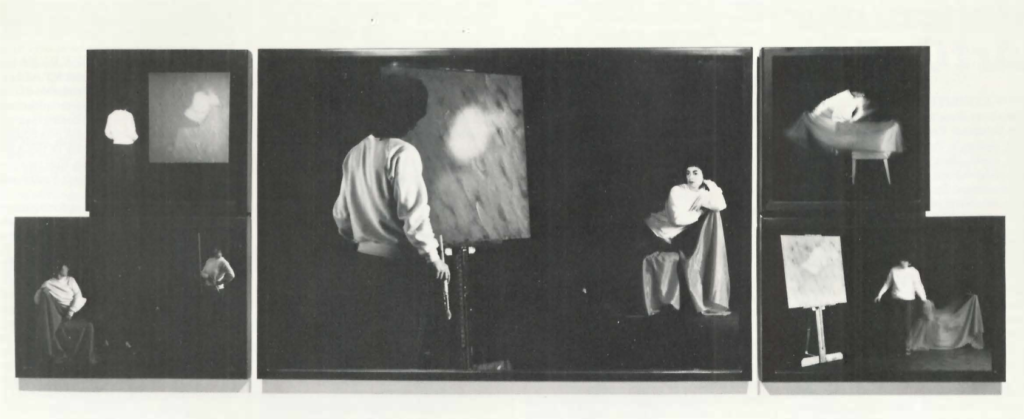Sorel Cohen (1983)

Graham, Robert. (1983) Sorel Cohen. In Vanguard, 12(4), p. 41.Sorel Cohen
Galerie Optica
Montreal
February 15 to March 5
P.S. 1
New York
April 10 to June 5
The development of artists often resembles the motion of nautical tacking: establishing direction, reversing, adjusting, correcting, repeating paths and avoiding dangers. In such ways artists chart courses which come to represent their unique concerns, investigations and discoveries within the regions they navigate.
Sorel Cohen’s new work, an extended and continuous metaphor, is the fifth series she has exhibited since her photographic career began in 1977. In the life-size triptych and pentaptych shown, Cohen has reemployed herself as model and actor in performing tableaux. Using double and triple exposures, she plays the several parts of portraitist, sitter and observer in wry sketches on the theme of artistic production.
She appears as a constant, dressed in white sweatshirt and blue jeans against a dark background, some times adorned with or resting upon a large remnant of bright red cloth. Within such an abstracted volume, the various elements of basic colours, characters and a few simple props are arranged. The results are complex and. visually stunning.
As sitter, she adopts the heroic poses of a figure in the work of, say, Ingres or Canova. The ‘artist’ produces nimbic images connoting painterly expressiveness and second generation representation: heavy brushstrokes, cloudy and auratic. One portrait is particularly remindful of a Sargent. The effect of all this is to place everything within the frame in inverted commas, so that when a figure is shown in a blur of motion, it appears as if Cohen were quoting even herself.
Abandoning the grid, she has organized the photographs in formats borrowed from Flemish altarpieces; hierarchical rather than linear and sequential, this ordering of the parts composes a circuit of relations and readings.
This pageant (as Clement Green berg recently called the impossible and artificial congregation in a Fra-Angelico Crucifixion) of types shows the person of the artist alternatively pompous and serving; the sitter as both commanding and docile, while the posture of the viewer suggests an attitude of awe or sometimes delectation.
I believe that Cohen’s strategy is twofold: first, she is correcting a fault she perceived and once commented upon in a work similar to metaphor by Sylvia Sleigh. Sleigh had produced a double portrait of herself as artist and the critic John Perrault as model in which she seemed to masculinize her self and feminize the sitter in a simple reversal of roles. By making the persons identical, and therefore indistinct, Cohen succeeds in restoring difference to its proper place at the level of symbolic relationships. She presents a purer demonstration of dominance and submission beyond particular bodies, while showing how difference manifests itself through bodies by means of gesture, stance, regard, distance, etc.
And secondly, Cohen reminds us that power is not an attribute but a relation and permutable. Artists or sitters or observers can each be dominant or submissive in their roles, depending upon their relationships in that role.
Formally and semantically, the work functions to keep the eye and mind in perpetual motion. The circular relationship between the parts and the ambiguous relationships among the depicted figures confounds our attempt at resolution. As Anthony Wilden has noted, punctuation is power – specifically, it determines sequence and order, and who is to be cause and who effect. This reversing, mirroring and endless contradiction creates an oscillation which in life is pathology, but in art, often funny. The laughter this work provokes indicates its satirical aspect.
Cohen’s work also serves to sup port, however, tentatively, a possible sociology of sight – a study of the protocols we follow in our looking and showing and covering and neglecting. Such rules inhibit or encourage our opportunities for display and observation.
Of course, the issues touched upon here and the forces at play are also recapitulated on the metalevel of our own experience with an extended and continuous metaphor – but such a topological analysis would propel us beyond the bounds of this occasion.
Robert Graham